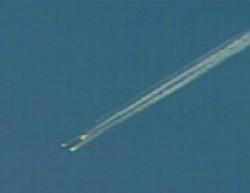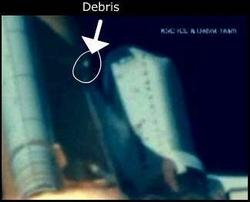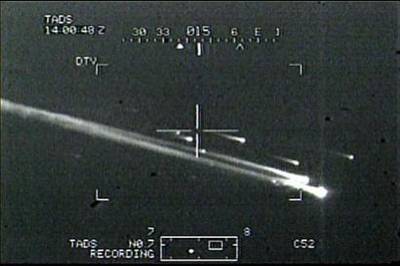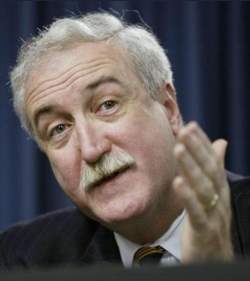Engineer's Emails Warned Of Potential Crisis
 In the
days before Columbia disintegrated upon re-entering
Earth's atmosphere, a NASA safety engineer emailed his supervisors,
warning the shuttle was at risk for a breach near its left wheel.
The email suggested others in the space agency weren't treating the
possibility seriously enough.
In the
days before Columbia disintegrated upon re-entering
Earth's atmosphere, a NASA safety engineer emailed his supervisors,
warning the shuttle was at risk for a breach near its left wheel.
The email suggested others in the space agency weren't treating the
possibility seriously enough.
"We can't imagine why getting information is being treated like
the plague," the engineer wrote in one of a series of e-mails
released by NASA on Friday.
By now, most of us have seen the video of Columbia's
lift-off. Just 80 seconds into the flight of STS-107, a chunk of
insulating foam can be clearly seen to break away from the huge
orange fuel tank and impact the orbiter on the underside of the
left wing. Now, newly-released documents show Columbia may
have been struck by as many as three large chunks of foam that
smashed against delicate insulating tiles.
 Engineer Robert Daugherty, who works at NASA's
Langley research facility in Hampton, Va., explicitly warned in an
email Jan. 29 that "one of the bigger concerns" was that damage to
thermal tiles near Columbia's wheel compartment seal could
permit a breach there. He appeared mostly worried about pilots
struggling to land Columbia with one or more tires damaged
from extreme heat.
Engineer Robert Daugherty, who works at NASA's
Langley research facility in Hampton, Va., explicitly warned in an
email Jan. 29 that "one of the bigger concerns" was that damage to
thermal tiles near Columbia's wheel compartment seal could
permit a breach there. He appeared mostly worried about pilots
struggling to land Columbia with one or more tires damaged
from extreme heat.
"It seems to me that if mission operations were to see both tire
pressure indicators go to zero during entry, they would sure as
hell want to know whether they should land with gear up, try to
deploy the gear or go bailout," Daugherty wrote.
The accident board investigating the disaster has previously
determined that Columbia almost certainly suffered a
devastating breach along its wing and possibly its wheel well - one
that allowed searing air to seep inside during its descent at
nearly 12,500 miles per hour. At this point, investigators believe
the heat literally melted parts of the wing, causing
Columbia to disintegrate over Texas.
Earlier this week, investigative board member James Hallock said
investigators were "very much interested also in the landing gear
door itself, because once again you have tiles all around the area,
but you also have seals."
Unusual temperature readings inside the wing and wheel
compartment began within minutes of the shuttle's re-entry, far off
the coast of California.
Senior Controllers Never Knew About The Debate
 Senior NASA officials maintain concerns expressed
in emails among midlevel engineers such as Daugherty were part of a
"what-if" analysis, and that even these engineers were satisfied
with Boeing's conclusions.
Senior NASA officials maintain concerns expressed
in emails among midlevel engineers such as Daugherty were part of a
"what-if" analysis, and that even these engineers were satisfied
with Boeing's conclusions.
"During the flight, no one involved in the analysis or the
management team or the flight team raised any concerns," said NASA
spokesman James Hartsfield on Friday.
But the emails disclosed in Washington questioned some details
about assurances by shuttle contractor Boeing that the foam impact
was of little or no consequence. Some of the emails included
underlying assumptions about the likelihood of minor damage from a
large chunk of breakaway foam and whether damage to
Columbia might have been caused by falling ice.
The emails also include references by Daugherty and another
Langley employee, Mark J. Shuart, about secrecy within NASA about
the study of risks to Columbia. Shuart wrote Jan. 28 to
two other employees, referring to the foam strike, "I am advised
that the fact that this incident occurred is not being widely
discussed."
In Houston, senior mission controllers handling STS-107
apparently never saw the emails. They will now be turned over to
the investigative board, according to spokeswoman Laura Brown.
The emails had been sought since last week by news organizations
under the Freedom of Information Act. Employees at NASA's
headquarters here published them Friday on the agency's Web
site.
"...the equivalent of a 500-pound safe hitting the wing at 365
mph."
 Among the emails were two written after the
breakup. Daniel D. Mazanek of NASA's Spacecraft and Sensors Branch
at Langley wrote Feb. 7 that debris striking Columbia
might have been ice, not foam from the external fuel tank.
Among the emails were two written after the
breakup. Daniel D. Mazanek of NASA's Spacecraft and Sensors Branch
at Langley wrote Feb. 7 that debris striking Columbia
might have been ice, not foam from the external fuel tank.
Boeing had calculated that a chunk of foam that weighed 2.67
pounds was involved. But Mazanek estimated that ice the same size
would have been more damaging because it would weigh 63.4 pounds,
"the equivalent of a 500-pound safe hitting the wing at 365
mph."
Last week, NASA disclosed a similar, worrisome e-mail by
Daugherty. He wrote two days before Columbia's breakup
about risks to the shuttle from "catastrophic" failures caused by
tires possibly bursting inside the wheel compartment from extreme
heat.
Daugherty was responding in that e-mail to a telephone call Jan.
27 from officials at the Johnson Space Center asking what might
happen if Columbia's tires were not inflated when it
attempted to land.
Three Hits Instead Of One?
In other documents released Friday, a newly disclosed Boeing
report said cameras saw three large pieces of debris, each up to 20
inches long, that shattered into a shower of particles after
striking Columbia along its left wing. The report, among
those supporting Boeing's assurances to NASA that Columbia
could return safely, was dated eight days before the spacecraft
broke apart.
Earlier Boeing reports during Columbia's flight had
focused on possible damage from "a large piece of debris," also
about 20 inches.
NASA released three reports Friday analyzing possible damage to
Columbia's insulating tiles. News organizations had
previously obtained two of these. The third, dated Jan. 24,
indicated the highest risk of damage was along the leading edge of
Columbia's left wing, based on the speed and on the angle
of the strike as the shuttle roared skyward.
Searching Nevada
Investigators are searching the area of Caliente (NV) for what
could be a piece of Space Shuttle Columbia debris believed
to have been tracked by air traffic control radar after it was shed
early in the spacecraft's descent over California and Nevada Feb.
1.

Video imagery of Columbia's entry provided to NASA was
analyzed by imagery, trajectory and ballistics experts. The results
of that analysis were then provided to National Transportation
Safety Board officials who reviewed air traffic control radar
imagery in that area during the time of Columbia's
descent. The review resulted in what is believed to be a
significant radar track of a piece of debris as it fell to Earth.
As a result, a search of the Caliente area near the Nevada-Utah
border is under way using Civil Air Patrol assets. A search using
additional means also may be forthcoming.
Similar work to narrow the possible locations of other debris
believed to have been shed by Columbia above the U.S.
Southwest continues, although no other areas have yet been
identified for further investigation.
About 25,000 pounds of Columbia debris is now at
Kennedy Space Center in Florida. That total is about 11
percent of the orbiter's weight as it descended from orbit.
About 5,600 items from the spacecraft currently are at KSC.
The search for Columbia debris continues in Texas and
Louisiana. So far, no confirmed Shuttle debris has been found
west of Granbury, Texas, near Fort Worth.
The Forest Service says more than 2,100 searchers should be in
the field by Friday. They'll be a part of more than 100 teams based
in Corsicana, Nacogdoches, Hemphill and Palestine, Texas. Bad
weather hampered the search on Thursday. The search is being
intensified to beat the area's spring bloom, which would make
debris harder to find.
 NASA
Administrator Sean O'Keefe Thursday re-emphasized the Agency's
intent not to launch another Space Shuttle until the cause or
probable cause of the Columbia accident is found and
corrected.
NASA
Administrator Sean O'Keefe Thursday re-emphasized the Agency's
intent not to launch another Space Shuttle until the cause or
probable cause of the Columbia accident is found and
corrected.
At a press conference from Stennis Space Center in Mississippi,
O'Keefe told reporters NASA would do nothing to compromise the
Agency's emphasis on safety. "Nothing I'm aware of that would
suggest than anything we did should cause us to change the way we
do business" in that area, he said.
NASA's position is still that there is no favorite theory about
the cause of the Columbia accident. "It's all on the
table," O'Keefe said in response to a reporter's question.
 ANN's Daily Aero-Linx (04.16.24)
ANN's Daily Aero-Linx (04.16.24) Aero-News: Quote of the Day (04.16.24)
Aero-News: Quote of the Day (04.16.24) Airborne 04.10.24: SnF24!, A50 Heritage Reveal, HeliCycle!, Montaer MC-01
Airborne 04.10.24: SnF24!, A50 Heritage Reveal, HeliCycle!, Montaer MC-01 Airborne 04.12.24: SnF24!, G100UL Is Here, Holy Micro, Plane Tags
Airborne 04.12.24: SnF24!, G100UL Is Here, Holy Micro, Plane Tags Airborne-Flight Training 04.17.24: Feds Need Controllers, Spirit Delay, Redbird
Airborne-Flight Training 04.17.24: Feds Need Controllers, Spirit Delay, Redbird








